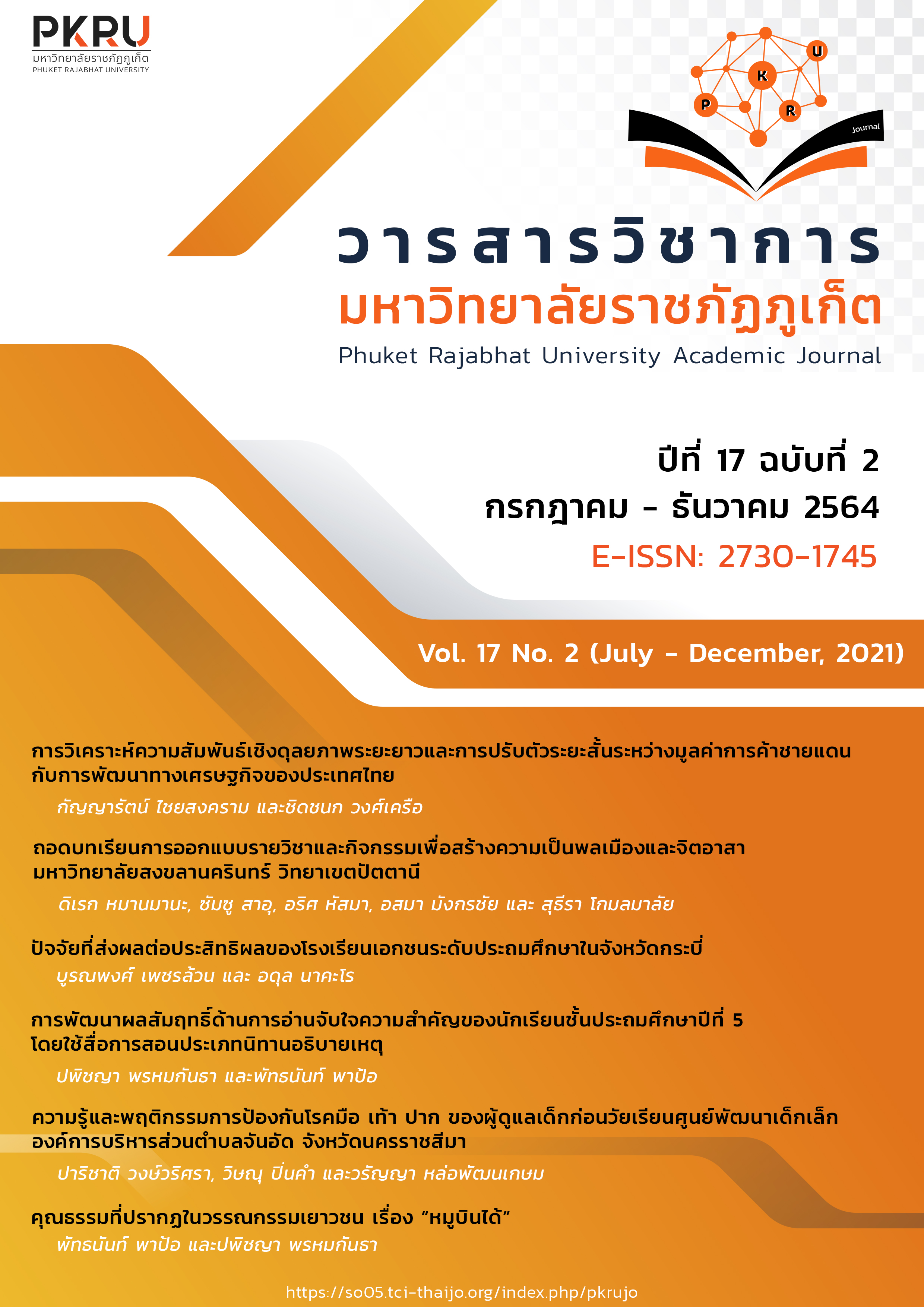การวิเคราะห์ความสัมพันธ์เชิงดุลยภาพระยะยาวและการปรับตัวระยะสั้นระหว่างมูลค่าการค้าชายแดนกับการพัฒนาทางเศรษฐกิจของประเทศไทย
Main Article Content
บทคัดย่อ
การวิจัยนี้มีวัตถุประสงค์เพื่อวิเคราะห์ความสัมพันธ์ระหว่างมูลค่าการค้าชายแดนและการพัฒนาทางเศรษฐกิจของประเทศไทย ซึ่งข้อมูลที่ใช้เป็นข้อมูลอนุกรมเวลารายไตรมาส ได้แก่ ข้อมูลผลิตภัณฑ์มวลรวมในประเทศ มูลค่าการค้าชายแดนระหว่างประเทศไทยและสาธารณรัฐประชาธิปไตยประชาชนลาว สาธารณรัฐแห่งสหภาพเมียนมา ประเทศมาเลเซีย และราชอาณาจักรกัมพูชา ตั้งแต่ไตรมาส 1 ปี พ.ศ. 2550 ถึง ไตรมาสที่ 2 ปี พ.ศ. 2562 โดยใช้แบบจำลอง Cointegration และ Error Correction ผลการศึกษาพบว่า มูลค่าการค้าชายแดนของประเทศไทยและสาธารณรัฐประชาธิปไตยประชาชนลาว ประเทศมาเลเซีย และราชอาณาจักรกัมพูชา มีความสัมพันธ์ระยะยาวในทิศทางเดียวกันกับการพัฒนาทางเศรษฐกิจของประเทศไทยและมีค่าสัมประสิทธิ์ เท่ากับ 5.91x10-5 , 1.66x10-5 และ 7.05x10-5 และ ตามลำดับ ในทางกลับกันมูลค่าการค้าชายแดนของสาธารณรัฐแห่งสหภาพเมียนมามีความสัมพันธ์ระยะยาวในทิศทางตรงกันข้ามกับการพัฒนาเศรษฐกิจของประเทศไทยและค่าสัมประสิทธิ์ เท่ากับ 4.68x10-6 แต่ไม่มีนัยสำคัญทางสถิติ และหากเกิดการเปลี่ยนแปลงระดับของมูลค่าการค้าชายแดนระหว่างประเทศไทยและสาธารณรัฐประชาธิปไตยประชาชนลาว สาธารณรัฐแห่งสหภาพเมียนมา ประเทศมาเลเซีย ราชอาณาจักรกัมพูชาจะสามารถปรับตัวเข้าสู่ดุลยภาพในระยะยาวด้วยขนาด 0.0784 0.0614 0.0922 และ 0.1813 ตามลำดับ
Article Details
เนื้อหาและข้อมูลในบทความที่ลงตีพิมพ์ในวารสารวิชาการมหาวิทยาลัยราชภัฏภูเก็ต ถือเป็นข้อคิดเห็นและความรับผิดชอบของผู้เขียนบทความโดยตรง ซึ่งกองบรรณาธิการวารสารฯ ไม่จำเป็นต้องเห็นด้วยหรือร่วมรับผิดชอบใด ๆ
บทความ ข้อมูล เนื้อหา รูปภาพ ฯลฯ ที่ได้รับการตีพิมพ์ในวารสารวิชาการมหาวิทยาลัยราชภัฏภูเก็ต ถือเป็นลิขสิทธิ์ของวารสารวิชาการมหาวิทยาลัยราชภัฏภูเก็ต หากบุคคลหรือหน่วยงานใดต้องการนำทั้งหมดหรือส่วนหนึ่งส่วนใดไปเผยแพร่ต่อหรือเพื่อกระทำการใด ๆ จะต้องได้รับอนุญาตเป็นลายลักษณ์อักษรจากวารสารวิชาการมหาวิทยาลัยราชภัฏภูเก็ตก่อนเท่านั้น
เอกสารอ้างอิง
Aranyaprathet Customs House. (2019). General Knowledge about Border Trade. Retrieved December 1th, 2019 from http://www.arancustoms.org/index.php?lay=show&ac=article&Id=570 872
Box, G. E. P., & Jenkins, G. M. (1976). Time Series Analysis: Forecasting and Control. Holden-Day.
Chompuphan, S. (2005). Testing of the relationship between border trade and Chiang Rai's money supply growth. [Master’s thesis], Chiang Mai University.
Department of Social Development and Welfare (2020). border trade management problems and obstacles. Retrieved December 15th, 2020 from http://www.dsdw2016.dsdw.go.th/doc_pr/ndc_2559-2560/PDF/wpa_8248/%E0%B8%9A%E0%B8%97%E0%B8%97%E0%B8%B5%E0%B9%88%203.pdf
Department of Trade Negotiations (2019). Definition, Meaning, Importance “Border Trade”. Retrieved December 1th, 2019 from http://www.aseanthai.net/ewt_news.php?nid=5585&filename=index
Engle, R. F., & Granger, C. W. (1987). Co-integration and error correction: representation, estimation, and testing. Econometrica, 55(2), 251 - 276.
Gong, C., & Kim, S. (2018). Regional business cycle synchronization in emerging and developing countries: Regional or global integration? Trade or financial integration?. Journal of International Money and Finance, 84, 42 - 57.
Julio, B., & Yook, Y. (2016). Policy uncertainty, irreversibility, and cross-border flows of capital. Journal of International Economics, 103, 13 - 26.
Mingmaninakin, W. (2000). Macroeconomics principles. (8th ed.) Thai Watana Panich.
Nam, D., & Wang, J. (2015). The effects of surprise and anticipated technology changes on international relative prices and trade. Journal of International Economics, 97(1), 162 - 177.
Rangsee, P. (2010). An analysis of relationship between exchange rate and border trade in Northern Thailand. [Master’s thesis], Chiang Mai University.
Sharma, C., & Pal, D. (2018). Exchange rate volatility and India's cross-border trade: A pooled mean group and nonlinear cointegration approach. Economic Modelling, 74, 230 - 246.
Sriboonchitta, S. (2004). Econometrics theory and applications. Faculty of Economics, Chiang Mai University.
Tomita, N. (2012). Factors affecting trade in value along the border of Maesot District, Tak Province. [Master’s thesis], Huachiew Chalermprakiet University.
Tubpun, Y. (2014). Economics of International Trade: Theory and Policy. (3rd ed.). Lada Limited Partnership.


